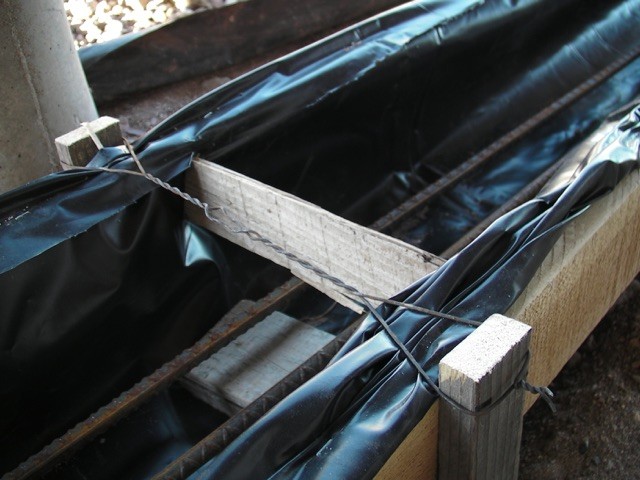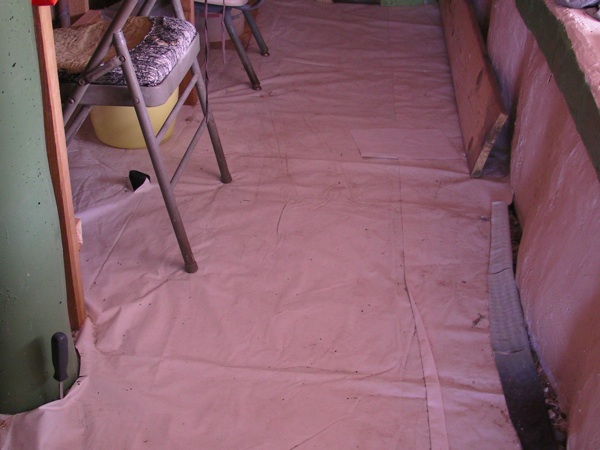
There are several different types of fabric that can be used in construction, but mostly they fall into two categories: woven (textile) and solid (plastics). The type of fabric needed depends upon the project at hand, and what is available to you locally.
The uses of fabric really are limitless, so for the purpose of this article, we will list a few, to give you an idea of the scope.
 We use a black plastic for concrete forms. They are inexpensive, flexible, and can be easily adapted to create beautiful imprints on your concrete. We no longer use solid forms for pouring concrete posts or foundations. And, if you protect your forms from the sun, they are reusable. For more information, see our instructions on fabric-formed posts and foundation.
We use a black plastic for concrete forms. They are inexpensive, flexible, and can be easily adapted to create beautiful imprints on your concrete. We no longer use solid forms for pouring concrete posts or foundations. And, if you protect your forms from the sun, they are reusable. For more information, see our instructions on fabric-formed posts and foundation.
Tarps and liners are good for underground waterproofing, too. Place the liner up against your wall, and backfill with a drainage layer, like gravel. This will keep your underground space dry!
 We like to use vinyl tarps as a retaining wall. We drive rebars into the ground, attach a tarp to them and then back fill with dirt. You can then stucco the outside to make it more durable.
We like to use vinyl tarps as a retaining wall. We drive rebars into the ground, attach a tarp to them and then back fill with dirt. You can then stucco the outside to make it more durable.
We use this same system, but on a larger scale, in a method of building we have devised, called Rapidobe. It is one of the cheapest and quickest forms of building we have used.
 One of the best uses for fabric is to make a latex concrete roof. For this, we actually use two different types of fabric. First, we attach a vinyl tarp to the roof structure, as a vapor barrier. Then, on top of the tarp, we secure a fabric with a loose weave that is encased in acrylic concrete. We use orchard netting, as it is very cheap where we live. For full instructions on this method, see our how-to about latex concrete.
One of the best uses for fabric is to make a latex concrete roof. For this, we actually use two different types of fabric. First, we attach a vinyl tarp to the roof structure, as a vapor barrier. Then, on top of the tarp, we secure a fabric with a loose weave that is encased in acrylic concrete. We use orchard netting, as it is very cheap where we live. For full instructions on this method, see our how-to about latex concrete.
 For a porch roof, the vapor barrier is not as important, so you don’t need the vinyl tarp. In fact, you can make the work go very fast by dipping a fabric like burlap into a vat of latex concrete, and then attaching it, wet, to your frame. You can use strips and then attach them with an overlap. Latex concrete adheres to itself very well, so you needn’t worry about cold joins. The result is a hard, permanent covering for whatever project you are doing. Although latex concrete sets up very fast, it will continue to harden for several weeks after.
For a porch roof, the vapor barrier is not as important, so you don’t need the vinyl tarp. In fact, you can make the work go very fast by dipping a fabric like burlap into a vat of latex concrete, and then attaching it, wet, to your frame. You can use strips and then attach them with an overlap. Latex concrete adheres to itself very well, so you needn’t worry about cold joins. The result is a hard, permanent covering for whatever project you are doing. Although latex concrete sets up very fast, it will continue to harden for several weeks after.
 There are many times when you don’t want to spend the time or money to lay a proper floor, like in a storage space or when you’re just too busy right now. We have found that a screened sand bed, covered with a vinyl tarp, makes a great temporary floor. It feels great to walk on, both soft and temperate, and can still be swept and mopped.
There are many times when you don’t want to spend the time or money to lay a proper floor, like in a storage space or when you’re just too busy right now. We have found that a screened sand bed, covered with a vinyl tarp, makes a great temporary floor. It feels great to walk on, both soft and temperate, and can still be swept and mopped.
If you are using this method as a temporary measure, you can leave the tarp in place when you lay your floor. You will have been compacting it by walking on it, and the tarp will act as a vapor barrier. You can also put carpet down on top of the fabric.
A special kind of plastic fabric can be used as a windowpane. It is supposed to be very strong and durable, as well as being much easier to customize than glass or Plexiglas.
We have not yet tried this yet, although we have bought the plastic and are planning to get to it soon… when we have time.
 Fabric can really finish out an interior for you. Whether carpet, curtain or furniture coverings, you can make it beautiful and functional.
Fabric can really finish out an interior for you. Whether carpet, curtain or furniture coverings, you can make it beautiful and functional.
You need little more than a sewing machine and some imagination to transform your home with fabric.
 Shade cloth is used extensively in gardening. If you experience extreme heat, you can help lesson it for your plants by stringing up some shade cloth on some posts. Quick and fairly cheap, and if you secure it properly to the posts, it will last for several years.
Shade cloth is used extensively in gardening. If you experience extreme heat, you can help lesson it for your plants by stringing up some shade cloth on some posts. Quick and fairly cheap, and if you secure it properly to the posts, it will last for several years.
 Plastic fabric makes a pretty decent greenhouse material. For long term, it is better to go with a hard plastic. However, we often like to make a prototype to see how something will suit us, both in design and location. And for this purpose, a cheaper material is often preferable until we are sure of what we want to do long term.
Plastic fabric makes a pretty decent greenhouse material. For long term, it is better to go with a hard plastic. However, we often like to make a prototype to see how something will suit us, both in design and location. And for this purpose, a cheaper material is often preferable until we are sure of what we want to do long term.
 Plastic or vinyl fabric is great as a temporary weatherproofing. It will not last forever in the sun, but if you want to protect something from the rain quickly and on a temporary basis, it’s great. We use a vinyl tarp to cover hay, cement and other items we store somewhere for only a while (like during a building project, or a season).
Plastic or vinyl fabric is great as a temporary weatherproofing. It will not last forever in the sun, but if you want to protect something from the rain quickly and on a temporary basis, it’s great. We use a vinyl tarp to cover hay, cement and other items we store somewhere for only a while (like during a building project, or a season).
We also dry hay that we cut on a tarp, so that it will collect any loose bits that come off the plant as it dries.
All in all, fabrics are very useful materials, and not to be overlooked.